Pedestrian refuges, also known as refuge islands or pedestrian islands are elongated, raised portions of pavement within the roadway that provide a place for pedestrians to wait whilst undertaking a staged crossing of a road. Pedestrian refuges can be contained within a flush median. Examples are shown below.
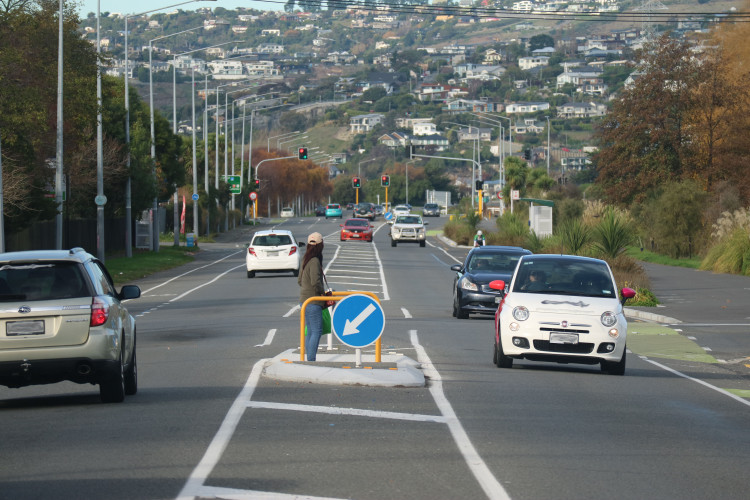
Pedestrian waiting in refuge to cross second traffic stream on Linwood Ave, Christchurch. (Photo: Ben Jassin)
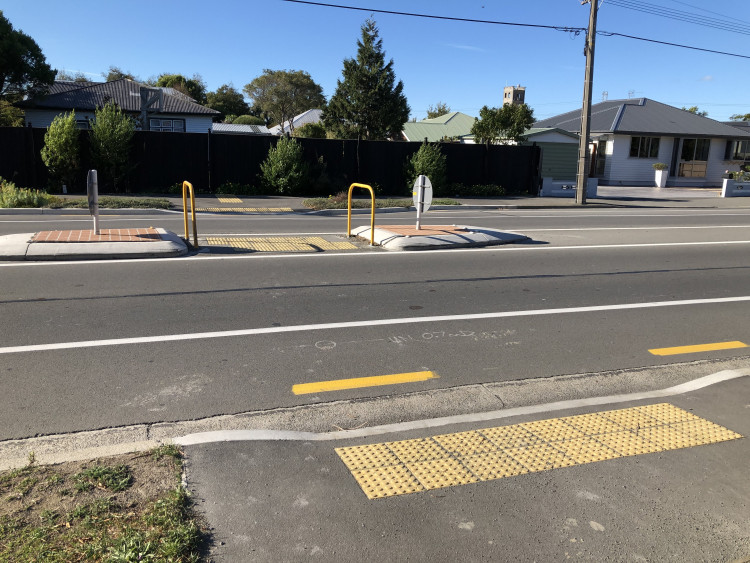
Pedestrian refuge, Christchurch. (Photo: Ann-Marie Head)
Median refuges are provided within a continuous raised median and are similar to pedestrian refuges in that they provide a place for pedestrians to wait whilst undertaking a staged crossing of a road. An example of a median refuge is shown below.
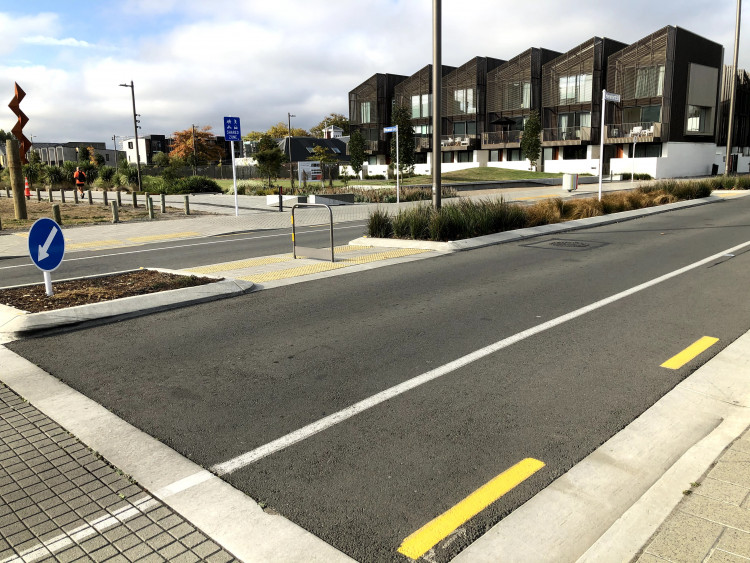
Median refuge, Hereford Street, Christchurch. (Photo: Ann-Marie Head)
Flush medians with solid islands located at regular intervals (to prevent the median being used by vehicles) can be helpful for some pedestrians by providing a place to pause while crossing two traffic streams. However, flush medians do not provide physical protection from traffic meaning they are only suitable for some pedestrians and should not be relied on as a suitable crossing type for all pedestrians.
Check whether a pedestrian or median refuge is a suitable treatment for your site by referring to:
PNG: Crossing selection process
The Crossing aids and pedestrian delay section discusses the effect of pedestrian/median refuges on pedestrian delay compared with other treatments.
PNG: Crossing aids and pedestrian delay
On their own pedestrian/median refuges are most beneficial on roads where traffic flows exceed 500 vehicles per hour. Pedestrian/median refuges can be combined with kerb extensions and platforms.
Pedestrian/median refuges permit a staggered layout when used at these crossing facility types:
A pedestrian/median refuge is a type of traffic island. An RCA may provide a traffic island to guide a pedestrian to a place at which to cross a roadway (TCD Rule, 8.8(4)) and the device must convey a clear and consistent message to road users (TCD Rule, 8.8(5)). One of the reasons an RCA can install a traffic island is to provide protection for pedestrians, cyclists or other road users crossing a road.
When providing a raised traffic island an RCA must install reflectorised signs and markings and delineation on the road beside the island to inform drivers of the presence of the island (TCD Rule, 7.7(1&2)).
Land Transport Rule: Traffic Control Devices 2004
Pedestrian islands should be built as kerbed islands (0.15m to 0.18m above the road’s surface) and be a different colour from the road. Pedestrians should be able to access the island or median without an abrupt change in level, ie step-free. Low landscaping or signage that does not obscure pedestrians (including children or people in wheelchairs) can be included on the island or median. Kerb ramps on the adjacent footpaths must be provided.
There are three different pedestrian island layouts as illustrated and described below.
The straight walk-through is a common layout that provides direct access for pedestrians.
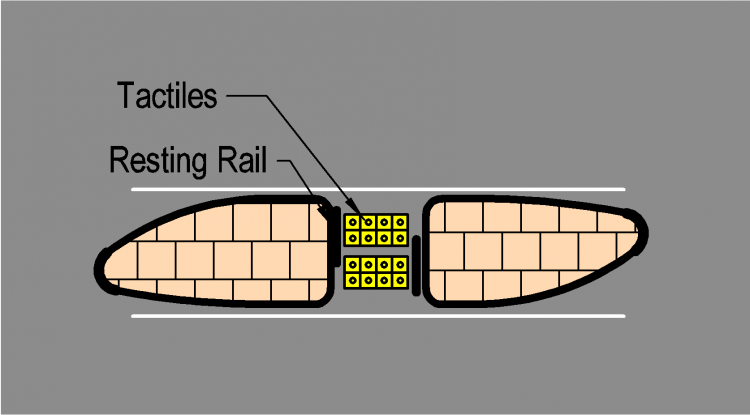
Straight walk-through layout option.
Also known as a diagonal refuge, the angled walk-through may be appropriate for larger, wider pedestrian islands as pedestrians are turned to face oncoming traffic. Note an angle in the opposite direction is not appropriate as pedestrians are directed away from oncoming traffic.
The ‘points’ on the cut-through can be potential trip hazards and tactile indicators are more complex to lay out.
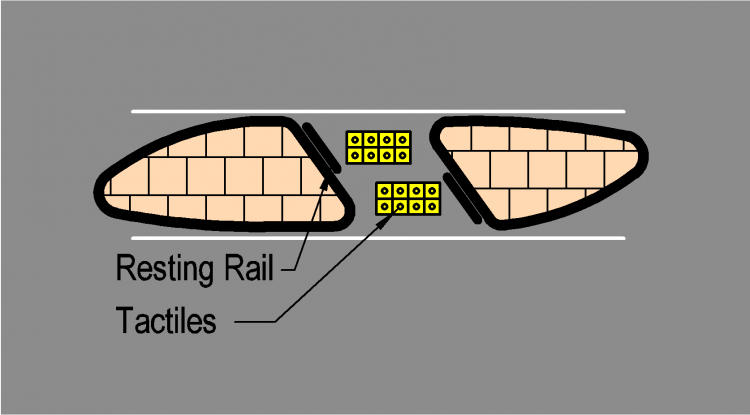
Angled walk-through layout option.
The chicane layout is generally a last resort option for stand alone pedestrian refuges but can be useful for median divided roads combined with traffic signals or zebras where the stagger clearly creates two crossings that operate separately. A chicane arrangement can hold more pedestrians on narrow roads. Safety fencing is required to guide pedestrians through the island, which can itself present a safety hazard under vehicle impact and increases maintenance requirements.
This layout also increases crossing distances and can be awkward for people with prams, wheelchairs and bicycles to negotiate hence the through route through a chicane refuge should provide for the manoeuvring of mobility scooters.
Horizontal geometric design for mobility scooters (TAN #21-06)
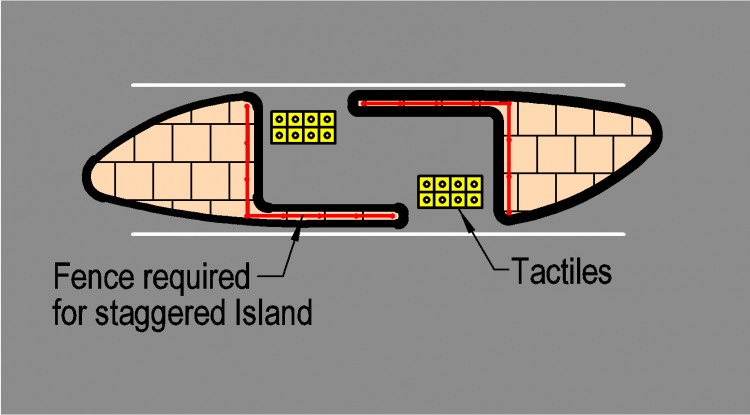
Chicane layout option.
If there is another pedestrian island nearby, consider linking the two with a continuous raised or flush median. If a flush median already exists, it should be smoothly widened if necessary to enclose the raised island. Traffic lanes should never terminate immediately before an island.
When providing pedestrian refuges, or any device that narrows the roadway, it is important to maintain enough width for cyclists and vehicles to pass each other or alternatively the traffic lanes should be narrow so that cyclists and drivers travel in single file and share the lane. Refer to Cycling Network Guidance for appropriate cycle lane widths and TCD Manual Part 5 for wide and narrow traffic lane width guidance.
The appropriate width must be maintained along all approaches and departures, so in constrained situations this may mean removing car parking. Good practice examples of this are shown below. Refer to the TCD Manual Part 5 and Cycling Network Guidance for appropriate dimensions depending on the context and speed environment.
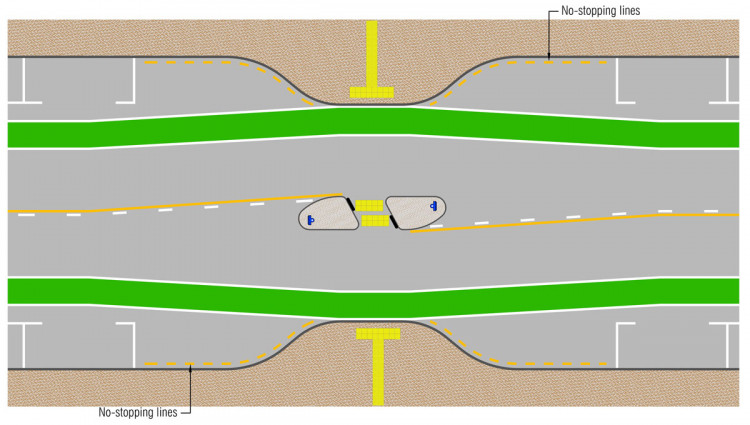
Typical layout of a pedestrian refuge island with cycle lanes. (Source: TCD Manual Part 5)
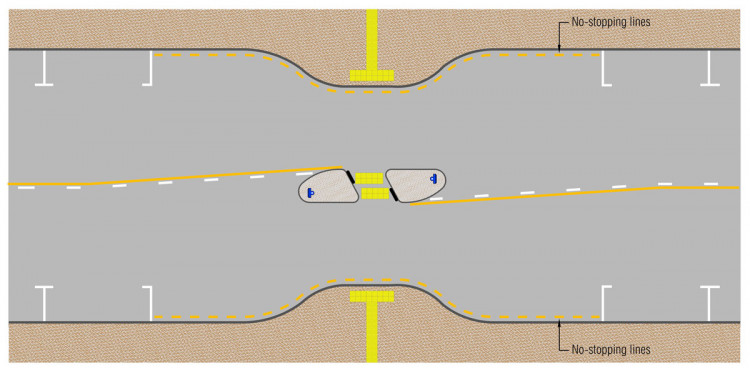
Typical layout of a pedestrian refuge island without cycle lanes. (Source: TCD Manual Part 5)
The table below outlines the design elements of pedestrian refuges and the figure shows a typical pedestrian refuge layout.
Table: Design elements of pedestrian refuges
|
Element |
Requirement |
Additional information |
|
Islands (if a pedestrian refuge) |
Length at least 8m |
Site specific according to:
|
|
Approach nosing taper |
1 in 10 or refer to Council specifications |
|
|
Approach nosing radius |
0.6m or refer to Council specifications |
|
|
Median depth |
At least 1.8m, preferably 2m |
This is required so that waiting pedestrians and their belongings do not protrude into adjacent traffic lanes. Consider an increased depth (2.5m) where people on bicycles will use the refuge (for example where the refuge connects to a shared path). Where the roadway has a constrained width, the desirable width can be achieved by narrowing the traffic lanes. |
|
Width of route through refuge |
At least 1.8m or the width of the adjacent kerb ramps (whichever is greatest) |
The actual width should be based on the potential number of pedestrians waiting on the island, so it is also affected by the island’s depth. The route through the island should accommodate mobility scooters. Horizontal geometric design for mobility scooters (TAN #21-06) |
|
Ramps within the refuge |
If provided, there must be a level area between ramps of at least 1.2m |
It is preferable to not change grade within the refuge and use a cut-through instead. If ramps are used, they must comply fully with the kerb ramp design criteria. |
|
Holding rails (also known as resting rail) |
1m high At least 0.35m from the kerb face at the edge of adjacent traffic lane(s) |
Ideally two holding rails either side or one central rail are provided to give choice for people who may only have use of one side of their body. Rails should be frangible to avoid injury to drivers whose vehicles leave the roadway, and built of iron pipe or some other such material (refer to Holding rail recommended design below). Holding rails should be conspicuous and painted in a contrasting colour to their surroundings. They should not reduce the route width to below the minimum and should have a bar near ground level that the vision impaired can detect with a cane. |
|
Fences |
These are required on a chicane layout to avoid creating a trip hazard |
For further guidance refer to |
|
Lighting |
In accordance with AS/NZS 1158.4:2015[2] |
Some RCAs have used a white globe (similar to a Belisha beacon) mounted on a 4m high white pole within the island. Floodlighting (as used for zebra crossings) has also been used. Lighting poles on islands must fold down for overdimension loads. |
|
Island kerbing |
Mountable splay kerbs |
Other kerbs are only acceptable if the traffic lanes more than 3m wide and the island is wider than 2m. It is advisable to paint the island kerbs with white or reflective paint. |
|
Signs |
R3-13 (‘keep left’) |
Keep left signs installed as close to the island ends as possible and facing oncoming vehicles. Not required if refuge is within a continuous median. No more than 0.15m between the bottom of the sign and the island surface. |
|
Roadway markings |
Refuge island is usually contained within a flush median. |
Flush median paint marking including end tapers are provided in the |
|
Overdimension routes |
Maintain at least 10m wide and 6m high envelope |
To achieve this envelope islands may need to have mountable kerbs and load bearing surfaces, with signs, poles and rails that can be removed or folded at ground level. Refer to |
|
Tactile indicators |
Warning indicators are required |
Refer to figure below for indicative layouts for different refuge types. Further information is provided in |
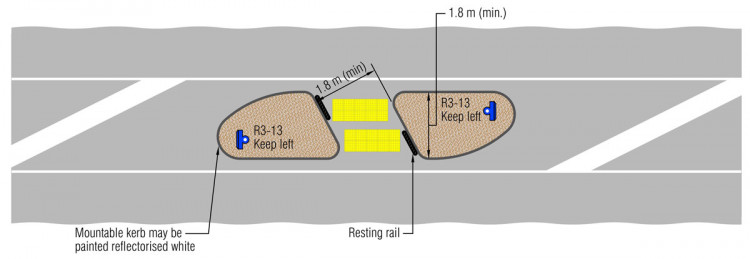
Typical pedestrian refuge design. (Source: TCD Manual Part 5)
The figure below shows the recommended holding rail design. It includes a lower bar that enables people using a cane to detect the rail.
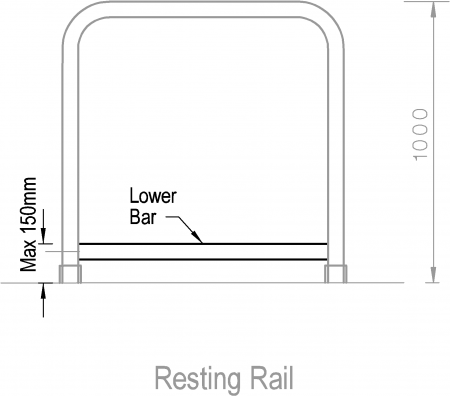
Holding rail recommended design.
Chicane type pedestrian/median refuges must have a physical barrier, rail or similar to encourage pedestrians to cross at the cut through or kerb ramps provided. The barrier should provide good visual contrast with the surrounding environment. An example of a chicane pedestrian refuge is shown below.
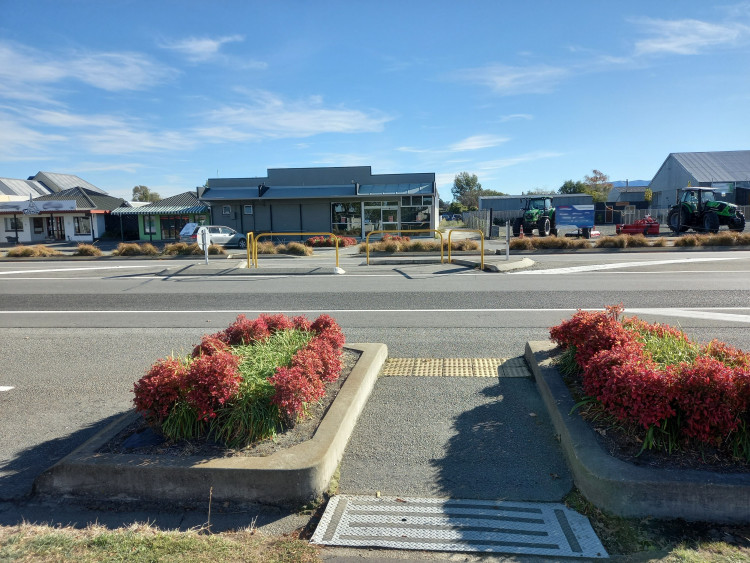
Chicane pedestrian refuge, Amberley. (Photo: Jeanette Ward)
The location of warning tactile indicators on pedestrian refuges or medians depends on the depth of the waiting space and whether the cut through is staggered. Directional indicators should only be installed between the warning indicators where there is no kerb to follow or where other cues are insufficient.
Further information on the layout of tactile indicators is provided below:
PNG: Designing for blind and low vision people
RTS 14 – Guidelines for facilities for blind and vision impaired pedestrians [PDF, 1.6 MB]
[1] Corben, B. (2020). Integrating Safe System with Movement and Place for Vulnerable Road Users(external link), Austroads, AP-R611-20, p19
[2] AS/NZS 1158.4: 2015(external link) Lighting for roads and public spaces Part 4: Lighting of pedestrian crossings